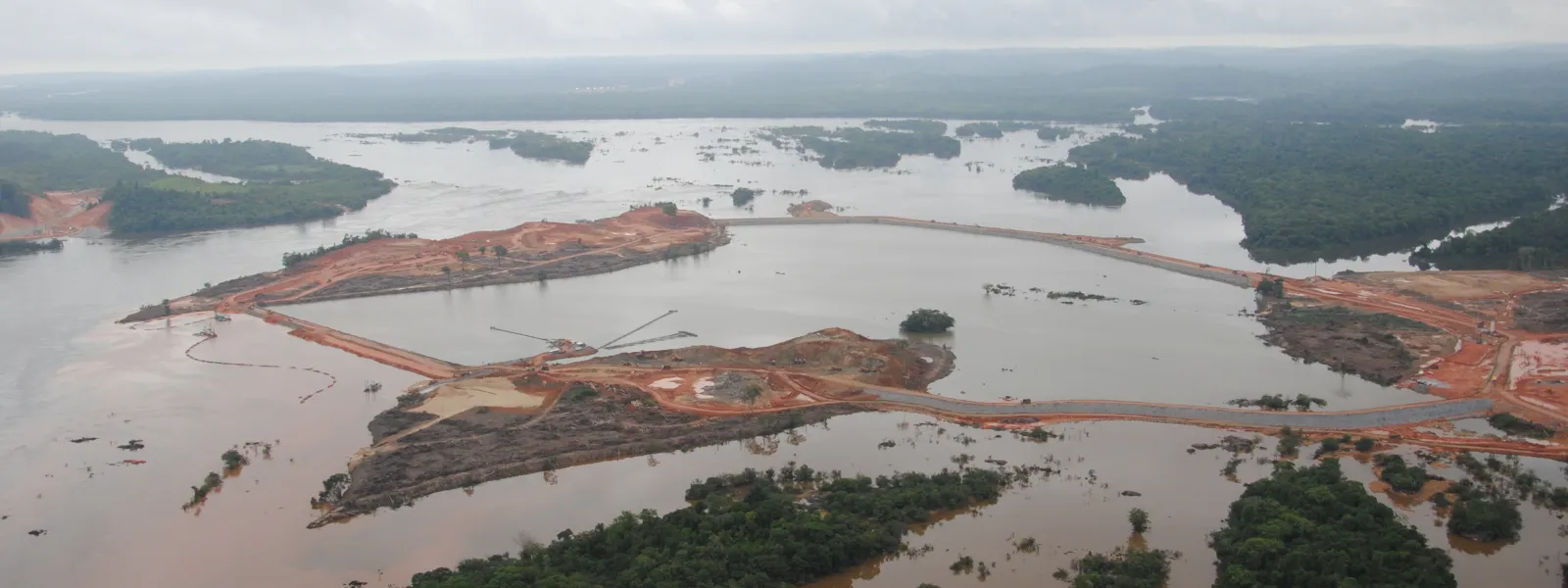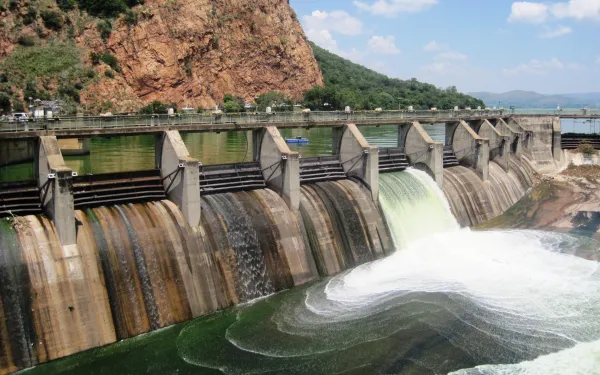
Project
Programa de Aceleração do CrescimentoHalting the implementation of large dams in the Americas
The more we learn, the clearer it becomes that large dams are unsustainable energy sources.
From the Mexican highlands to the Amazon River basin, hydroelectric mega-projects are aggravating climate change, destroying sensitive ecosystems, and threatening human rights and indigenous cultures.
In October 2016, a research study from Washington State University found that the world’s reservoirs generate 1.3 percent of all greenhouse gases (more than the total emissions of Canada!), confirming the damage dams do to our climate.
Large dams have no place on our rapidly changing planet. In a time of intensifying droughts, many vulnerable hydropower-dependent countries are facing energy shortages. And as extreme weather events increase around the world, the inherent danger of large dams becomes more evident.
Throughout the construction of Belo Monte, the world’s third largest dam, we’ve seen firsthand the grave impacts these projects have on the ecosystems in which they’re built. We’ve witnessed the violations they impose on the rights of indigenous and riverine communities, whose culture and livelihoods are tied so closely to the natural world.
Yet, across Latin America and the world, large dams are still being promoted as “clean and green” energy sources; and are even receiving support from national and international climate initiatives.
That support is part of the reason more than 3,700 large dams are currently being planned or constructed worldwide, more than 400 of which have been proposed for the vital Amazon River Basin.
At AIDA, we’re proud to be part of a team leading the fight against large dams across Latin America and beyond.
Partners:

Related projects
Latest News

The link between international environmental law, human rights and large dams
The article is an update and reissue of two chapters of the report Large Dams in the Americas: Is the Cure Worse than the Disease, written by Jacob Kopas and Astrid Puentes Riaño. The article identifies “the main obligations, standards, decisions and international law applicable to large hydropower plants that our governments should use in the planning, implementation, operation and closure of these projects." The article is divided into two parts. Chapter I offers an overview of the main standards, the legal framework of international human rights and environmental law as well as the decisions and international jurisprudence applicable to the cases of large dams. In Chapter II, this framework is applied to the cases of human rights abuses caused by the degradation of the environment through the development of a large dam.
Read more
Large dams in the Americas: Is the cure worse than the disease?
Large dams consistently cause severe, and often irreversible, environmental and social damage. Their construction is also often associated with violations of international human rights and environmental laws. AIDA’s report Large Dams in the Americas: Is the Cure Worse than the Disease? explores these grave impacts and explains the existing international standards that should be applied to protect the environment and human rights. The report also exposes the dangers of using large hydroelectric dams to meet increasing energy demands in Latin America. To promote greater protection of human rights, AIDA gave testimony based on this dams report to the Inter-American Commission on Human Rights (IACHR) at a general hearing on November 2, 2009. AIDA has also shared the report’s findings with international experts, policymakers, non-governmental organizations, affected local communities, and international financial institutions such as the World Bank and the Inter-American Development Bank. Furthermore, AIDA staff presented legal strategy workshops at "Rivers for Life 3", an international meeting of dam-affected communities in Temacapulín, Mexico, October 1-7, 2010. The previous month, AIDA staff represented Latin America on a panel of water experts at World Water Week in Stockholm. In Large Dams in the Americas, AIDA examines five large hydroelectric dams in violation of a range of environmental and human rights laws: Yacyretá in Argentina and Paraguay, Río Madeira in Bolivia and Brazil, Baba in Ecuador, Chan-75 in Panama, and La Parota in Mexico. Through these case studies, AIDA illustrates how governments generally disregard important international obligations and standards, such as the need to conduct proper environmental and social impact assessments. In the report, we also explain the significant social and environmental impacts caused by large dams. We discuss how families suffer when they are displaced or forcefully evicted by dams and lose valuable farmland, water sources, or traditional fishing areas. We document how the people most harmed by large dams are those from vulnerable populations, including indigenous, afro-descendent and poor farming communities. We also describe how large dams typically harm the environment by flooding valuable ecosystems, dramatically altering natural flows of water, disrupting wildlife habitat, and obstructing the migratory paths of perse species, among other impacts. In addition, Large Dams in the Americas dispels the myth that dams are a source of "green energy". Even though dams do not rely on fossil fuels to generate electricity, they still contribute to greenhouse gas emissions. Hydroelectric dams create enormous reservoirs of river water that submerge valleys and lead to the decomposition of vast amounts of organic matter. As the trees and other biomasses break down, they release carbon dioxide and methane, the same greenhouse gases that are created by "dirty" technologies like coal-fired electricity plants. Turbines also liberate methane trapped in deep water and emit carbon dioxide as they release pressure from the reservoir. In tropical regions, dams can emit as much as eleven times the amount of greenhouse gases that a conventional power plant of equivalent size would emit. Given the negative impacts of large dams, AIDA's report recommends that policymakers seriously consider alternatives that protect human rights and our natural ecosystems, save energy, and reduce greenhouse gas emissions. Suggested alternatives include: improving energy efficiency, reducing demand, making better use of sustainable energy sources, investing in energy-efficient technologies and infrastructure, and removing barriers that hinder technology exchange between nations. AIDA wrote this report in collaboration with our participating organizations, CEMDA, CEDHA, ECOLEX and Earthjustice, as well as International Rivers, Sobrevivencia, and the Association for Conservation and Development (ACD). By educating governments, policymakers, communities, and other key players about large dams, we seek to encourage authorities to investigate the matter and apply our recommendations on how to implement dam projects in compliance with international laws. Spanish-Language Report Available Here
Read moreAIDA Presents Report on Large Dams Before the Inter-American Development Bank (Spanish)
Para Publicación Inmediata: 19 de Marzo de 2010 Contacto: Astrid Puentes Riaño - AIDA, +(52-1-55) 23016639, [email protected] Informe: Grandes Represas en América ¿Peor el remedio que la enfermedad? AIDA PRESENTA DOCUMENTO ANTE EL BID El objetivo del documento es el de promover un mejor entendimiento de la situación, evidenciar la vinculación entre los graves impactos ambientales y la violación a los derechos humanos que las grandes represas pueden causar. Cancún, México – La Asociación Interamericana para la Defensa del Ambiente, AIDA, presentará el informe: “Grandes Represas en América, ¿Peor el remedio que la enfermedad?” ante el Banco Interamericano de Desarrollo, BID. La presentación se hará en el marco de la Reunión Anual de Gobernadores del BID que se celebra en Cancún, hasta el 23 de marzo. En esta reunión, entre otros, el BID decidirá acerca de la recapitalización del Banco para promover mayores inversiones en el hemisferio. “Esperamos que las futuras inversiones financiadas por el BID y otras Instituciones Financieras Internacionales tengan en cuenta este informe, así como los estándares internacionales para estos proyectos, incluyendo las recomendaciones de la Comisión Mundial de Represas” declaró Astrid Puentes, co-directora de AIDA. “Esto podría Así podrían evitar graves impactos ambientales y a los derechos humanos, y promover verdaderos proyectos de energía limpia”. El objetivo del Informe es evidenciar la vinculación entre los graves impactos ambientales y la violación a los derechos humanos que las grandes represas pueden causar y motivar la implementación de proyectos de energía adecuados. Para ello, se analizan cinco estudios de caso de distintas regiones de América Latina: La Parota (México), Chan 75 (Centroamérica), Baba (región Andina), Río Madeira (Brasil) y Yacyretá (Cono Sur). El informe preparado por AIDA en coordinación con International Rivers y con la cooperación de múltiples organizaciones no gubernamentales y de comunidades afectadas por las grandes represas en el hemisferio, se presentó también en noviembre pasado ante la Comisión Interamericana de Derechos Humanos (CIDH) en Washington. La CIDH celebró esta audiencia dada la importancia del tema para la adecuada protección de los derechos humanos en la región. Entre los impactos más graves generados por las grandes represas, abordados en el Informe, se incluyen: el empeoramiento de la calidad y salubridad de las aguas tanto río arriba como río abajo por la modificación artificial de las cuencas hidrográficas; la degradación de ecosistemas acuáticos; los impactos a la biodiversidad; los impactos en el cambio climático por el aumento en la emisión de gases efecto invernadero dada la descomposición de materia orgánica inundada; el posible aumento de actividad sísmica; la destrucción de ecosistemas estratégicos; el desplazamiento forzado de comunidades típicamente en situación de vulnerabilidad, como las indígenas, campesinas y afrodescendientes, así como las mujeres y los niños y las niñas; la pérdida de fuentes de alimentación y de sustento; la falta de participación pública y acceso a la información; la falta de consulta y la obtención del consentimiento libre, previo e informado de comunidades afectadas; y criminalización de la protesta social hacia personas o comunidades que defienden sus derechos. “Buscamos evitar estas consecuencias negativas y promover alternativas efectivas a las necesidades energéticas, para lograr un verdadero desarrollo sostenible”, puntualizó Jacob Kopas, abogado de AIDA y coautor del Informe. Versión completa del informe y Resumen Ejecutivo Para mayor información acerca de la situación de las grandes represas en América Latina visite: www.aida-americas.org www.internationalrivers.org www.redlar.org/
Read more